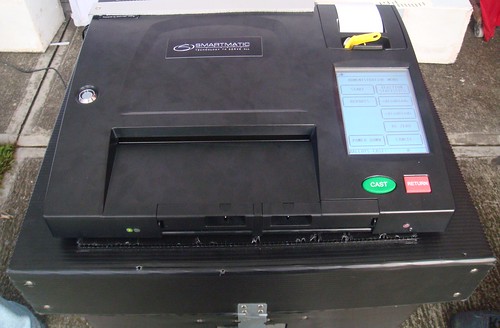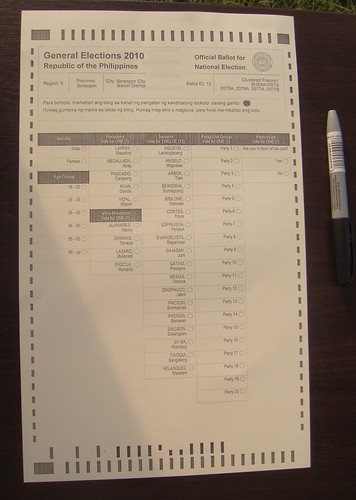
Sample of the PCOS machine that Smartmatic will use for the automated elections in 2010
Like any other first, next year’s automated elections on a nationwide scale have raised skepticism and doubt, with critics claiming that instead of addressing manual election problems, poll automation would only create confusion as no sufficient testing has been done. To ease the public's fears, Smartmatic - the foreign counterpart of the consortium that won the automation contract - joined GMA Network's "Tatakbo Ka Ba?" fun run Sunday to demonstrate how their Precinct Count Optical Scan (PCOS) machine would operate during the casting of votes. I personally tried the PCOS, and found the voting procedure easy and fast. A voter is only required to follow four simple steps: 1. Present an ID before the Board of Elections Inspectors for voter's authentication 2. Get a machine readable ballot 3. Cast votes 4. Feed the ballot to the machine Smartmatic spokesman Miguel Avila said safety nets are in place for the transmission of votes so that the machines would not become a playground for computer hackers. He assured the public that their machines and transmission are “100 percent hack-free." “All of the results are encrypted. When we say encrypted it's basically converting for example plain texts into something not humanly recognizable," he said. According to Avila, the technology they will use is similar to the program used for automated teller machines (ATM) in banks. “We could say that this technology is more secured because it gives hackers a window of only two minutes to intercept the data," Avila said.
In case of power interruption, which is a common problem in many areas, Avila said their machines have back-up batteries that could last for 12 hours. He said the voting procedure is held for only 11 hours so that would suffice in case power interruption occurs. Other people who also tried the machine found it hassle-free. I was almost impressed, until the machine encountered glitches. During the fifth trial the PCOS refused to accept the ballot. Public relations manager of Smartmatic Gene Gregorio told GMANews.TV that the problem occurred because the PCOS was still reading the fourth ballot when the fifth one was inserted. He was quick to add that it was a minor problem that would not affect the counting of votes. This was the second time that Smarmatic's PCOS encountered glitches during demonstrations. Last May, its demo machine short-circuited during a demonstration in front of the Commission on Elections bids committee because of faulty wiring. [See:
Comelec exec, Smartmatic deny P2 million bribery]

'UNIQUE': Smartmatic says the bar codes surrounding the ballot provide unique identification that ensures no ballot will be inserted in the PCOS machine twice.
Gregorio said the company has 2000 PCOS machines reserved for the 2010 elections. He said these machines would be distributed in a strategic manner nationwide to ensure that there will be replacements in case some machines bog down. While everybody could give Gregorio – and the entire Smartmatic company for that matter – the benefit of the doubt, it is undeniable that the last thing a voter wants to see is a machine glitch, especially when the country's hopes for changes in the government are pinned in next year’s elections. After all, in Smartmatic’s technology lies the fate of 90 million Filipinos. Poll automation author Senator Richard Gordon said there is nothing to fear with the present system. Gordon, who was a participant in the fun run, said the public should remain vigilant instead. He expressed confidence that Smartmatic, as an international contractor, would take care of its reputation.
“Pag nagloko sila hindi na sila makakakuha ng kontrata sa ibang bansa." -
GMANews.TV 






